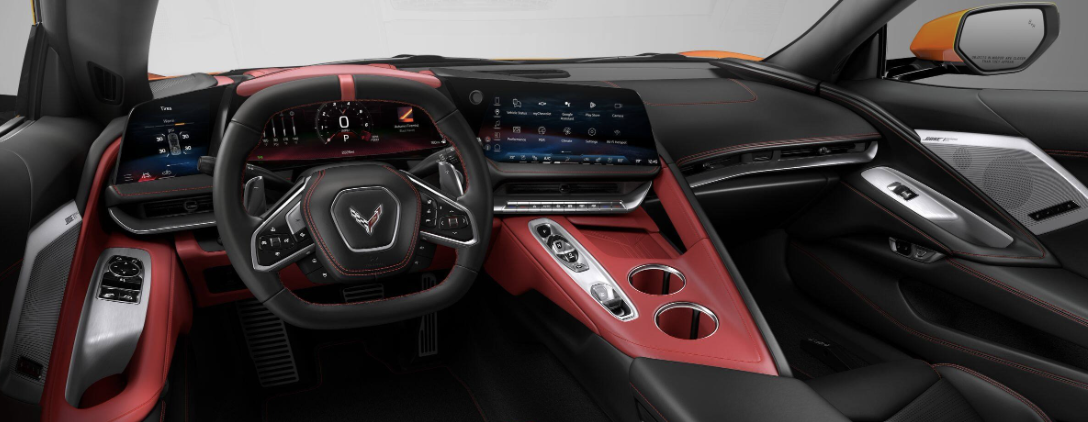Case Study: Chevrolet Corvette Redefined
The driver-centric cockpit experience
Story
Overview
For the 2026 model year, Chevrolet reimagined the Corvette cabin—not just as a driver’s cockpit, but as a shared, digital ecosystem designed around connection, precision, and performance.
My role as UX Lead was to help translate that vision into an experience that merged luxury and functionality, integrating cutting-edge technology with intuitive usability.
We set out to replace the polarizing “button wall” that previously divided the driver and passenger with an open, fluid, and human-centered design—a cabin that celebrates both the driver’s control and the passenger’s inclusion.
2018 Corvette
2026 Corvette
My Role
Lead Experience Designer - Corvette Framework, Climate Controls & Home
Focus: In-Vehicle UX, Display Ecosystem, Infotainment Integration
The Challenge
The C8 Corvette’s interior had been performance-driven but visually and functionally divided. Feedback highlighted:
Cognitive overload from the vertical “button wall.”
Limited passenger inclusion in the driving experience.
Fragmented control surfaces between digital and physical elements.
A growing expectation for integrated connectivity and performance analytics aligned with modern digital ecosystems.
Our goal:
Design a cockpit that feels purposeful and driver-centric—yet inclusive, intuitive, and beautifully digital.
Research & Insights
We conducted driver and passenger ride-along studies, track-day observations, and post-drive interviews across Corvette owners, enthusiasts, and first-time buyers.
Key insights:
Drivers wanted focus: no visual clutter, direct access to performance data.
Passengers wanted inclusion: visibility into key information and comfort controls.
Owners valued familiarity: tactile reassurance for essential functions.
Track users craved data: real-time analytics without distraction.
This informed a design strategy built around intentional minimalism, progressive disclosure, and adaptive interaction—balancing physical tactility with digital precision.
Design Framework
We redefined the infotainment and instrumentation system through a multi-layered UX framework:
Spatial Clarity — Replace the “button wall” with an open, balanced console featuring a passenger grab handle for shared engagement.
Information Hierarchy — Introduce a triple-screen display that wraps around the driver:
14″ Driver Information Center for critical performance data.
12.7″ Center Display for infotainment and navigation.
6.6″ Auxiliary Display for customizable metrics such as trip info and traction settings.
Responsive Modality — Allow the system to adapt dynamically between Tour, Sport, and Track modes, with graphics and themes that shift seamlessly by context.
Hybrid Interaction Model — Maintain a balance of physical and virtual controls, combining digital flexibility with tactile assurance.
Prototyping & Validation
I developed high-fidelity prototypes simulating multi-screen flow, motion, and latency across various driving conditions.
User validation focused on:
Glance time reduction for core interactions.
Driver immersion and cognitive load.
Cross-screen readability and hand positioning.
Passenger inclusion and shared visibility of media, navigation, and performance data.
The results shaped key refinements:
Relocated volume and drive-mode controls for reach efficiency.
Introduced a hand-rest ledge below the touchscreen for input comfort.
Enlarged and illuminated the volume knob for visibility and intuitive feel.
Drive Modes
The redesigned cockpit gives drivers intuitive control to switch between Tour, Sport, and Track modes—instantly transforming both the display and driving dynamics.
Impact
The 2026 Corvette interior redefines what a performance cockpit can be — an ecosystem of data, design, and emotion.
Key Outcomes:
Eliminated the “button wall”, creating an open, inclusive cabin environment.
Reduced visual complexity while expanding information access through the triple-screen display.
Improved usability and driver focus validated through glance-time and eye-tracking studies.
Enhanced personalization and connection via responsive, cross-device design.
Cemented Corvette’s leadership as a luxury performance benchmark in its segment.
Reflection
The 2026 Corvette showcases how thoughtful UX can elevate performance into experience—where every screen, stitch, and interaction supports the driver’s intent and the passenger’s inclusion.
By integrating hardware, software, and human insight, the project demonstrates that design is not just about control—it’s about connection.










